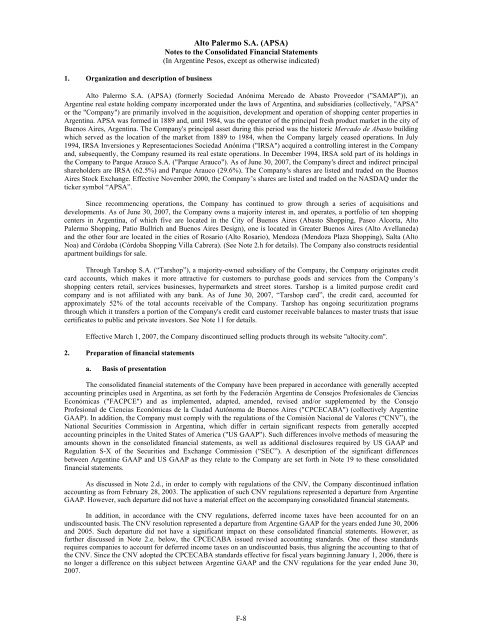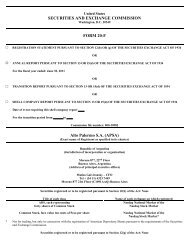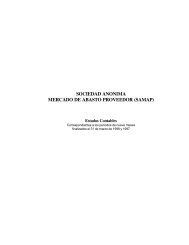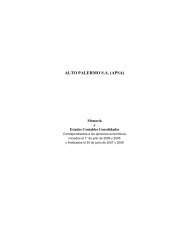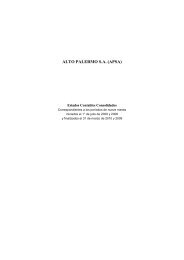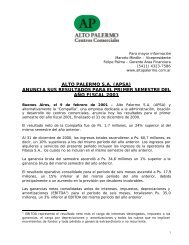Alto Palermo S.A. (APSA)
Alto Palermo S.A. (APSA)
Alto Palermo S.A. (APSA)
You also want an ePaper? Increase the reach of your titles
YUMPU automatically turns print PDFs into web optimized ePapers that Google loves.
1. Organization and description of business<br />
<strong>Alto</strong> <strong>Palermo</strong> S.A. (<strong>APSA</strong>)<br />
Notes to the Consolidated Financial Statements<br />
(In Argentine Pesos, except as otherwise indicated)<br />
<strong>Alto</strong> <strong>Palermo</strong> S.A. (<strong>APSA</strong>) (formerly Sociedad Anónima Mercado de Abasto Proveedor ("SAMAP")), an<br />
Argentine real estate holding company incorporated under the laws of Argentina, and subsidiaries (collectively, "<strong>APSA</strong>"<br />
or the "Company") are primarily involved in the acquisition, development and operation of shopping center properties in<br />
Argentina. <strong>APSA</strong> was formed in 1889 and, until 1984, was the operator of the principal fresh product market in the city of<br />
Buenos Aires, Argentina. The Company's principal asset during this period was the historic Mercado de Abasto building<br />
which served as the location of the market from 1889 to 1984, when the Company largely ceased operations. In July<br />
1994, IRSA Inversiones y Representaciones Sociedad Anónima ("IRSA") acquired a controlling interest in the Company<br />
and, subsequently, the Company resumed its real estate operations. In December 1994, IRSA sold part of its holdings in<br />
the Company to Parque Arauco S.A. ("Parque Arauco"). As of June 30, 2007, the Company's direct and indirect principal<br />
shareholders are IRSA (62.5%) and Parque Arauco (29.6%). The Company's shares are listed and traded on the Buenos<br />
Aires Stock Exchange. Effective November 2000, the Company’s shares are listed and traded on the NASDAQ under the<br />
ticker symbol “<strong>APSA</strong>”.<br />
Since recommencing operations, the Company has continued to grow through a series of acquisitions and<br />
developments. As of June 30, 2007, the Company owns a majority interest in, and operates, a portfolio of ten shopping<br />
centers in Argentina, of which five are located in the City of Buenos Aires (Abasto Shopping, Paseo Alcorta, <strong>Alto</strong><br />
<strong>Palermo</strong> Shopping, Patio Bullrich and Buenos Aires Design), one is located in Greater Buenos Aires (<strong>Alto</strong> Avellaneda)<br />
and the other four are located in the cities of Rosario (<strong>Alto</strong> Rosario), Mendoza (Mendoza Plaza Shopping), Salta (<strong>Alto</strong><br />
Noa) and Córdoba (Córdoba Shopping Villa Cabrera). (See Note 2.h for details). The Company also constructs residential<br />
apartment buildings for sale.<br />
Through Tarshop S.A. (“Tarshop”), a majority-owned subsidiary of the Company, the Company originates credit<br />
card accounts, which makes it more attractive for customers to purchase goods and services from the Company’s<br />
shopping centers retail, services businesses, hypermarkets and street stores. Tarshop is a limited purpose credit card<br />
company and is not affiliated with any bank. As of June 30, 2007, “Tarshop card”, the credit card, accounted for<br />
approximately 52% of the total accounts receivable of the Company. Tarshop has ongoing securitization programs<br />
through which it transfers a portion of the Company's credit card customer receivable balances to master trusts that issue<br />
certificates to public and private investors. See Note 11 for details.<br />
Effective March 1, 2007, the Company discontinued selling products through its website "altocity.com".<br />
2. Preparation of financial statements<br />
a. Basis of presentation<br />
The consolidated financial statements of the Company have been prepared in accordance with generally accepted<br />
accounting principles used in Argentina, as set forth by the Federación Argentina de Consejos Profesionales de Ciencias<br />
Económicas ("FACPCE") and as implemented, adapted, amended, revised and/or supplemented by the Consejo<br />
Profesional de Ciencias Económicas de la Ciudad Autónoma de Buenos Aires ("CPCECABA") (collectively Argentine<br />
GAAP). In addition, the Company must comply with the regulations of the Comisión Nacional de Valores (“CNV”), the<br />
National Securities Commission in Argentina, which differ in certain significant respects from generally accepted<br />
accounting principles in the United States of America ("US GAAP"). Such differences involve methods of measuring the<br />
amounts shown in the consolidated financial statements, as well as additional disclosures required by US GAAP and<br />
Regulation S-X of the Securities and Exchange Commission (“SEC”). A description of the significant differences<br />
between Argentine GAAP and US GAAP as they relate to the Company are set forth in Note 19 to these consolidated<br />
financial statements.<br />
As discussed in Note 2.d., in order to comply with regulations of the CNV, the Company discontinued inflation<br />
accounting as from February 28, 2003. The application of such CNV regulations represented a departure from Argentine<br />
GAAP. However, such departure did not have a material effect on the accompanying consolidated financial statements.<br />
In addition, in accordance with the CNV regulations, deferred income taxes have been accounted for on an<br />
undiscounted basis. The CNV resolution represented a departure from Argentine GAAP for the years ended June 30, 2006<br />
and 2005. Such departure did not have a significant impact on these consolidated financial statements. However, as<br />
further discussed in Note 2.e. below, the CPCECABA issued revised accounting standards. One of these standards<br />
requires companies to account for deferred income taxes on an undiscounted basis, thus aligning the accounting to that of<br />
the CNV. Since the CNV adopted the CPCECABA standards effective for fiscal years beginning January 1, 2006, there is<br />
no longer a difference on this subject between Argentine GAAP and the CNV regulations for the year ended June 30,<br />
2007.<br />
F-8


